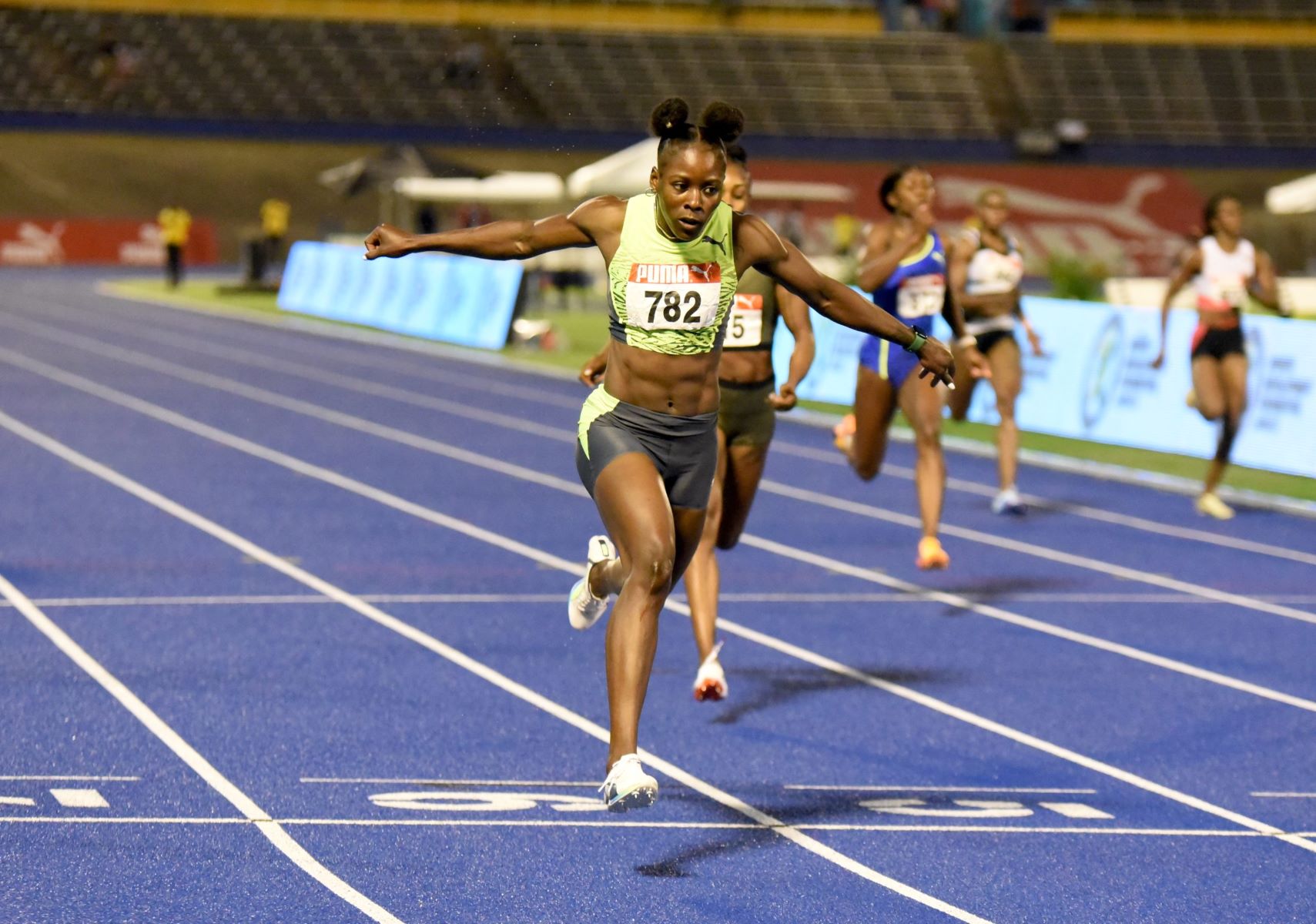

Featured
How Are Points Scored In Track And Field
Published: September 2, 2023
Discover how points are scored in track and field events with our featured guide. Learn about key scoring systems and rules in this comprehensive resource.
Introduction
Track and field is a thrilling and dynamic sport that combines speed, strength, and agility. Athletes compete in a variety of individual and team events, pushing themselves to achieve their best performances. As spectators, we cheer for our favorite athletes and marvel at their abilities, but have you ever wondered how points are scored in track and field?
In this article, we will explore the scoring system used in track and field, breaking down how points are allocated for individual events, relay events, and team competitions. We will also discuss the factors that affect the overall points scored by athletes and teams in these competitions.
Understanding the scoring system in track and field is essential for athletes, coaches, and fans alike. It provides a basis for evaluating and comparing performances, determining winners, and recognizing outstanding achievements. So, whether you are a seasoned track and field enthusiast or just starting to discover the sport, let’s dive into the exciting world of scoring in track and field.
Scoring System in Track and Field
The scoring system in track and field is designed to reward athletes for their performances in various events. It provides a method of evaluating and comparing performances across different disciplines, allowing for fair and equitable competition. The scoring system is based on a combination of factors such as distance, time, height, and technique.
Each individual event in track and field is assigned a specific point value based on the difficulty and significance of the event. The higher the level of achievement, the more points an athlete will earn. These points are then used to determine the overall winners in individual events, relay events, and team competitions.
The scoring system varies slightly depending on the type of event. In individual events, such as sprints, long jumps, and throwing events, athletes earn points based on their performance. This is typically done using score tables that assign point values to specific standards or benchmarks.
For example, in a sprint event, an athlete may earn a certain number of points based on their finishing time. The faster they run, the more points they accumulate. Similarly, in a throwing event, the distance achieved determines the number of points awarded to the athlete.
In relay events, the total points are usually divided equally among the members of the team. This means that each team member will receive an equal share of the total points based on the team’s performance.
In team competitions, such as track and field meets or championships, points are awarded to teams based on the individual performances of their athletes. These points are then totaled to determine the overall team scores. The team with the highest score at the end of the competition is declared the winner.
The scoring system in track and field is constantly evolving, with adjustments being made to reflect advancements in performance and changes in the sport. Governing bodies and associations regularly review and update the score tables to ensure they remain fair and effective in ranking athletes and determining winners.
Points Breakdown for Individual Events
In track and field, each individual event has its own unique scoring system. Points are awarded to athletes based on their performance in that particular event. The specific criteria for earning points vary depending on the nature of the event, whether it is a sprint, a jump, or a throw. Let’s explore the points breakdown for some of the common individual events:
- Sprints: In sprint events such as the 100-meter or 200-meter dash, points are typically awarded based on the athlete’s finishing time. Faster times result in more points earned.
- Distance Races: In longer distance races like the 800-meter, 1500-meter, or 5000-meter events, points are often assigned based on the athlete’s finishing position. The higher the place, the more points the athlete will earn.
- Jumping Events: In events like the long jump, high jump, and pole vault, points are awarded based on the height or distance achieved. Athletes earn more points if they clear higher heights or achieve longer distances.
- Throwing Events: In throwing events such as shot put, discus throw, and javelin throw, points are determined by the distance achieved. Athletes who throw farther earn more points.
These are just a few examples of how points are distributed in individual events. The specific point values and scoring systems may vary depending on the competition level, the governing body, and any specific event rules or regulations in place.
It is important to note that the point values assigned to performances in individual events are carefully calculated and standardized. This ensures consistency and fairness across different competitions, allowing for accurate comparisons of performances and determining winners.
Athletes participating in individual events strive to accumulate as many points as possible, aiming to achieve personal bests and surpass the predetermined benchmarks set by the scoring system. This drives athletes to push their limits and continuously improve, showcasing their skills and athleticism in the pursuit of higher scores.
Points Breakdown for Relay Events
Relay events in track and field, such as the 4x100m and 4x400m relays, add an exciting team dynamic to the sport. Scoring in relay events is slightly different compared to individual events, as the points earned are divided equally among the team members. Let’s take a closer look at the points breakdown for relay events:
In relay events, each team consists of multiple athletes who take turns running a specified distance before passing a baton to the next teammate. The overall performance of the team determines the points earned for that event.
Points are typically awarded based on the team’s finishing position in the race, similar to individual events. The team that finishes in first place typically earns the highest number of points, while subsequent places earn fewer points. These points are then evenly distributed among the team members, ensuring that each member receives an equal share.
For example, if a relay team finishes in first place and is awarded 10 points for their performance, each team member would receive 2.5 points (assuming a team of 4 members). This ensures equal recognition and participation among all team members.
It is important to note that some competitions may award bonus points or additional incentives for exceptional relay performances, such as breaking records or achieving fast times. These additional points can further enhance the team’s overall score.
Relay events require strong teamwork, precise baton exchanges, and seamless coordination among team members. The point distribution in relay events not only recognizes the team’s success but also encourages collaboration and mutual support.
Athletes participating in relay events work together towards a shared goal, motivating and pushing each other to maximize their individual performances for the benefit of the team. The scoring system in relay events reflects this collaborative effort, rewarding each team member for their contribution to the team’s overall success.
Points Calculation in Team Competitions
Team competitions in track and field involve multiple events and require the accumulation of points from various individual and relay performances. The points earned by athletes contribute to the overall team score, determining the winners of the competition. Let’s delve into the points calculation in team competitions:
In team competitions, such as track and field meets or championships, each athlete’s points from their individual events and relay performances are combined to form the team’s total score. The team with the highest score at the end of the competition emerges as the winner.
The points earned by athletes in their individual events, as described earlier, are added to the team’s score. Additionally, the points from relay events are divided equally among the team members and added to the cumulative total.
For example, if a team has multiple athletes competing in various individual events and relay races, their points will be added together to determine the team’s overall score. Each athlete’s contribution is crucial, and strong performances from all team members enhance the team’s chances of securing a higher score.
Team competitions often include a wide range of events, such as sprints, jumps, throws, and distance races. Each event contributes a specific number of points, usually determined by the event’s difficulty and significance. The team’s strategy may involve highlighting their strengths in specific events while ensuring consistent performances across all disciplines.
The team with the highest score at the end of the competition is crowned the winner. In some cases, there may be multiple divisions or categories based on factors like age, gender, or skill level. Each division may have its own separate scoring system and winners.
The intricacies of points calculation in team competitions can vary depending on the specific rules and regulations set by the governing body or organizing committee. It is essential for teams and athletes to familiarize themselves with the scoring system before participating in such events.
Team competitions in track and field foster a sense of camaraderie and collective achievement. Athletes come together to represent their schools, clubs, or countries, collaborating towards a common goal. The points calculation system recognizes and celebrates the combined efforts of all team members, ultimately determining the team’s success in the competition.
Factors Affecting Points Scored
Several factors can influence the number of points scored by athletes in track and field competitions. These factors can impact individual performances, relay events, and overall team scores. Let’s explore the key factors that affect the points scored:
Performance Level: The performance level of an athlete plays a significant role in determining the number of points earned. Achieving faster times, higher heights, longer distances, and better techniques can result in higher scores. Athletes who consistently perform at a high level have a greater chance of accumulating more points.
Competition Level: The level of competition in which an athlete or team is participating can have an impact on the points scored. Higher-level competitions often have stricter standards and benchmarks, making it more challenging to earn points. Additionally, competing against stronger opponents can push athletes to elevate their performances, potentially resulting in higher scores.
Event Difficulty: The difficulty of an event can influence the point values assigned to performances. Events that require exceptional skill, technique, or physical demand may have higher point allocations. This ensures that athletes who excel in more challenging events are appropriately rewarded for their accomplishments.
Environmental Conditions: Environmental conditions, such as weather and wind, can affect an athlete’s performance and subsequently impact their points scored. Factors like strong headwinds, heavy rain, or extreme heat can make it more difficult for athletes to achieve their best performances, potentially resulting in lower scores.
Injury or Fatigue: Injuries or fatigue can significantly impact an athlete’s performance and ultimately affect their points scored. Athletes who are injured or experiencing fatigue may not be able to perform at their best, resulting in lower scores. It is crucial for athletes to prioritize rest, recovery, and injury prevention to maintain optimal performance levels.
Strategy and Tactics: The strategic decisions made by athletes and teams can influence points scored in various ways. For individual events, athletes may choose to conserve energy during qualifying rounds and give their best performance in the final event. In relay events, effective baton exchanges, pacing strategies, and overall teamwork can contribute to higher scores.
Judging and Officiating: Points scored can also be affected by the subjective nature of judging and officiating in certain events. Judges and officials play a vital role in evaluating performances and assigning scores based on their expertise and judgment. Fair and consistent judging is crucial to ensure that athletes are awarded appropriate points.
These factors highlight the intricacies involved in determining the points scored by athletes in track and field competitions. Athletes and teams must consider these factors and adapt their strategies, training, and performances accordingly to maximize their scores and increase their chances of success.
Conclusion
The scoring system in track and field is a fundamental aspect of the sport, enabling fair competition and recognizing the achievements of athletes and teams. Understanding how points are scored in individual events, relay events, and team competitions is essential for athletes, coaches, and fans alike.
In individual events, points are awarded based on factors such as finishing time, distance, or height achieved. Athletes strive to surpass predetermined benchmarks and achieve personal bests to earn higher scores. In relay events, points are divided equally among team members based on the team’s performance. This encourages collaboration and teamwork among athletes.
In team competitions, individual and relay event points are combined to determine the overall team score. Strong performances in various events contribute to higher team scores, and the team with the highest score emerges as the winner.
Factors such as performance level, competition level, event difficulty, environmental conditions, injuries, strategy, and judging can influence the points scored by athletes. These factors highlight the dynamic nature of track and field and the need for athletes to adapt and perform at their best in different circumstances.
The scoring system in track and field undergoes regular review and updates to ensure fairness and accuracy in evaluating performances. Athletes and teams must familiarize themselves with the specific scoring rules and regulations of each competition to maximize their scoring potential.
In conclusion, understanding the scoring system in track and field adds depth and appreciation to the sport. It provides a framework for evaluating performances, determining winners, and recognizing outstanding achievements. Whether you are an athlete, coach, or fan, embracing the scoring system enhances your understanding and enjoyment of track and field as a thrilling and competitive sport.









